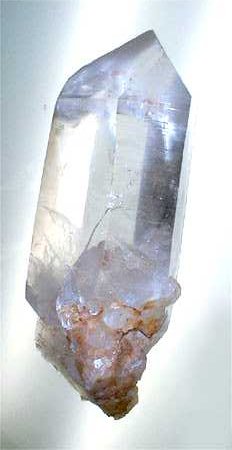Quartz
|
|
- For other uses of this word, see Quartz (disambiguation).
| Quartz | |
|---|---|

| |
| General | |
| Category | Mineral |
| Chemical formula (or Composition) | Silica (silicon dioxide, SiO2) |
| Identification | |
| Color | Clear (if no impurities); also see Varieties |
| Crystal habit | 6-sided prism ending in 6-sided pyramid (typical) |
| Crystal system | Trigonal |
| Cleavage | None |
| Fracture | Conchoidal |
| Mohs Scale hardness | 7 - lower in impure varieties |
| Luster | Vitreous |
| Refractive index | 1.544-1.553 - DR +0.009 (B-G interval) |
| Pleochroism | None |
| Streak | White |
| Specific gravity | 2.65 constant; variable in impure varieties |
| Melting point | |
| Solubility | |
| Major varieties | |
| Chalcedony | Any cryptocrystalline quartz, although generally only used for white or lightly coloured material. Otherwise more specific names are used. |
| Agate | Banded Chalcedony, translucent |
| Onyx | Agate where the bands are straight, parallel and consistent in size. |
| Jasper | Opaque chalcedony, impure |
| Aventurine | Translucent chalcedony with small inclusions (usually mica) that shimmer. |
| Tiger's eye | Fibrous quartz, exhibiting chatoyancy. |
| Rock Crystal | Clear, colourless |
| Amethyst | Purple, transparent |
| Citrine | Yellow to reddish orange, greenish yellow |
| Rose quartz | Pink, translucent, may display diasterism |
| Milk quartz, or snow quartz | White, translucent to opaque, may display diasterism |
| Smoky quartz | Brown, transparent |
| Morion | Dark-brown, opaque |
| Carnelian | Reddish orange chalcedony, translucent |
Quartz is the second most abundant mineral in the Earth's crust. It has a hexagonal crystal structure made of trigonal crystallized silica (silicon dioxide, SiO2), with a hardness of 7 on the Mohs scale. Density is 2.6 g/cm³. The typical shape is a six-sided prism that ends in six-sided pyramids, although these are often distorted, or so massive that only part of the shape is apparent from a mined specimen. Additionally a bed is a common form, particularly for varieties such as amethyst, where the crystals grow up from a matrix and thus only one termination pyramid is present. A quartz geode consists of a hollow rock (usually with an approximately spherical shape) with a core lined with a bed of crystals.
| Contents |
Varieties
Quartz is one of the world's most common crustal minerals and goes by a bewildering array of different names. The most important distinction between types of quartz is that of macrocrystalline (individual crystals visible to the unaided eye) and the microcrystalline or cryptocrystalline varieties (aggregates of crystals visible only under high magnification). Chalcedony is a generic term for cryptocrystalline quartz. The cryptocrystalline varieties are either translucent or mostly opaque, while the transparent varieties tend to be macrocrystalline.
Although many of the varietal names historically arose from the colour of the mineral, current scientific naming schemes refer primarily to the microstructure of the mineral. Colour is a secondary identifier for the cryptocrystalline minerals, although it is a primary identifier for the macrocrystalline varieties. This does not always hold true.
Not all varieties of quartz are naturally occurring. Prasiolite, an olive coloured material, is produced by heat treatment. Although citrine occurs naturally, the majority is the result of heat-treated amethyst. Carnelian is widely heat-treated to deepen its colour.
QuartzUSGOV.jpg
Because natural quartz is so often twinned, much quartz used in industry is synthesized. Large, flawless and untwinned crystals are produced in an autoclave via the hydrothermal process: emeralds are also synthesized in this fashion.
Quartz occurs in hydrothermal veins and pegmatites. Well-formed crystals may reach several metres in length and weigh hundreds of kilograms. Erosion of pegmatites may reveal expansive pockets of crystals, known as "cathedrals."
Quartz is a common constituent of granite, sandstone, limestone, and many other igneous, sedimentary, and metamorphic rocks.
Some quartz crystal structures are piezoelectric and are used as oscillators in electronic devices such as quartz clocks and radios.
A amorphous (glass) SiO2, called lechatelierite, is caused by lightning strikes in sand, distinct from typical window glass that is impure.
History
The name "quartz" comes from the German "Quarz", which is of Slavic origin.
Roman naturalist Pliny the Elder believed quartz to be permanently frozen ice. He supported this idea by saying that quartz is found near glaciers in the Alps and that large quartz crystals were fashioned into spheres to cool the hands. He also knew of ability of quartz to split light into a spectrum.
Nicolas Steno's study of quartz paved the way for modern crystallography. He discovered that no matter how distorted a quartz crystal, the long prism faces always made a perfect 60 degree angle.
Piezoelectricity
Quartz is also a type of piezoelectric crystal that creates electricity through a process called piezoelectricity when mechanical stress is put upon it. One of the earliest uses for a quartz crystal was a phonograph pickup. Today, one of the most ubiquitous piezoelectric uses of quartz is as a crystal oscillator -- in fact these oscillators are often simply called "quartzes".
See also
References and external links
- Hurlbut, Cornelius S.; Klein, Cornelis, 1985, Manual of Mineralogy, 20th ed., ISBN 0471805807
- Quartz group - Mineral Galleries (http://mineral.galleries.com/minerals/silicate/quartz.htm)
- Quartz - Mineral Galleries (http://mineral.galleries.com/minerals/silicate/quartz/quartz.htm)
- Quartz - Mineral.net (http://www.minerals.net/mineral/silicate/tecto/quartz/quartz.htm)
- Arkansas quartz (http://rockhoundingar.com/quartz.html)
- Nomenclature of Silica (http://www.minsocam.org/MSA/collectors_corner/arc/silicanom.htm)da:Kvarts
de:Quarz et:Kvarts es:Cuarzo eo:Kvarco fr:Quartz it:Quarzo he:קוורץ nl:Kwarts ja:石英 pl:Kwarc pt:Quartzo ro:Cuarţ ru:Кварц zh:石英
